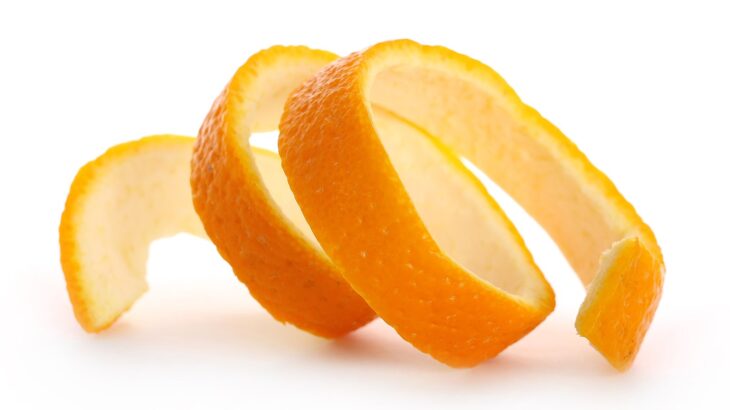By Zahra Nasser, Chemistry editor
It’s a fact that’s likely to turn some heads: composting certain kinds of food waste is not as good for the environment as we think. That’s because some food waste contains chemical compounds that are detrimental to local soil and water quality. It is important to understand the biochemical composition of anything we put into an ecological system before we can determine its potential impacts on the environment.
In terms of biodegradation and composting, citrus waste — primarily peel and seeds — poses a particular ecological risk. The mass decomposition of citrus food waste is problematic and leads to soil and water pollution. On a global scale, citrus waste accounts for almost half of fresh fruit waste. The industrial production of juices, jams, and essential oil extracts generates about 10 million megatons of citrus fruit waste each year—most of it ends up in landfills.
Due to improper waste disposal, citrus fruits do not decompose but rot, producing mold and toxins that are optimal breeding grounds for microbes and flies. The high acid content of citrus fruits also contributes to creating hostile composting environments, where the low pH kills the bacteria, insects, and other microorganisms involved in the decomposition process.
This is not to say that any and all citrus waste is harmful to soil. In moderate amounts, and balanced with non-acidic waste, biodegrading citrus waste can be beneficial. It provides nitrogen, phosphorous, and potassium—all essential compounds for supporting strong and healthy plant growth. And there is a method for composting citrus waste that mostly removes its volatile properties. The process requires dehydrating the peels to remove the water but it is costly and time consuming.
If not compost, then what?

Chemistry students from Mount Allison University win Samsung’s Solve for Tomorrow competition with their orange peel corkboard invention. Image: Enactus Mount Allison Facebook page.
Luckily, the bioactive properties of citrus fruit skins make them very useful as a recyclable material. For oranges, their porous peels, called the flavedo, and the leathery white skin under the flavedo, called the albedo, are packed full of phytochemicals such as pectin, cellulose, and fiber. Investigations into the biocomposition of orange peels have shown that they are suitable candidates for a variety of applications from energy production to cosmetics.
Recently, a group of undergraduate students at Mount Allison University in New Brunswick developed a way to process orange peel waste to make cork board. By exploiting the mechanical properties of orange peels, the students created a solid and spongy material that maintained its shape while remaining soft enough to be punctured by pins. Although the exact composition of the corkboard is being kept secret, the process involved drying and grinding the orange peels into an “oatmeal-like” base that is then pressed into moulds. The students won the 2022 Samsung’s Solve for Tomorrow competition with their invention.
But wait, there’s more
Recycling citrus waste holds great potential. In 2021, researchers at the University of Catania characterized orange peels using scanning electron microscopy. They examined the thermal, physical, and mechanical properties of orange peels to determine their suitability as a basic substance for producing building materials such as boards. They found that wet, rather than dry, peels performed better under mechanical and physical pressure. Their research also suggested that orange peels have greater thermal conductivity than artificial insulating material such as mineral wool and polystyrenes, an important consideration when creating building material and insulation. More work needs to be done, including testing the durability and degradation of the material, before deciding if orange peels can really be turned into long-lasting boards.
Aside from re-using the entire orange peels for a single product, the individual bioactive compounds of orange peels can be isolated. For example, pectin and carotenoids can be used in food production; pectin is a type of soluble fibre that is used as a thickening agent and carotenoids are plant pigments used as a colouring agent (red, orange, and yellow). The soluble fibre in citrus peels can also be used as a food additive to increase the fiber content of food.
Alternatively, orange peels can be used as biofuel. When exposed to high-powered microwaves, gases are released from the peel; these gases can be captured and refined. The Orange Peel Exploitation Company (OPEC) is dedicated to findings ways to make orange peels into bio-fuels. James Clark, a professor at the University of York and member of OPEC explains that, “The orange peel has an interesting chemical composition that makes it very easy to convert into fuel.” In February 2023, a team of researchers in Spain analyzed the biofuel potential of orange peels. They tested an 85% jet fuel/15% orange peel-derived biofuel combination which resulted in less soot and reduced carbon emissions.
It isn’t just the peel that can be successfully reprocessed. Citrus fruits seeds are a source of oils containing antioxidants and vitamin C. This oil can be extracted and used in the manufacture of essential oils, soaps, and lotions.
The potential of citrus waste recycling and reprocessing is well established but further research and development is needed to bring these products to the market. This research draws attention to how we deal with food waste and points to the recycling opportunities of other mass produced food waste. If we want to, we can build an environmentally sustainable future for food waste recycling from our broken food waste management system.
Feature image: Orange peels are the biggest contributor to fresh fruit waste and their improper disposal is hurting the environment. Image: Wikimedia Commons, CC BY-SA 4.0.





One thought on “More sour than sweet: the truth behind citrus waste”
Comments are closed.